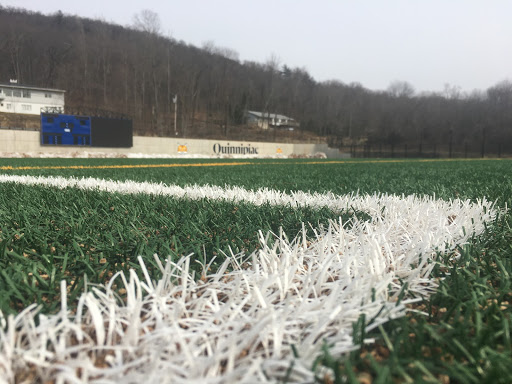By Ross Lager
Quinnipiac lacrosse and soccer teams haven’t always enjoyed a home-field advantage over the last year — in fact, they haven’t always had a home field to play on at all.
When the university built the $28 million lacrosse and soccer stadium two years ago, it chose to use a crumbly cork material to cushion the field and help the field’s artificial grass to stand up.
According to the Vice President of Facilities and Capital Planning, Sal Filardi, the university chose cork because it thought the material would have less impact on the wetlands bordering the field than the crumb rubber alternative. What it didn’t count on was that the cork would freeze in the wet winter weather, rise above the grass and create a slippery, unplayable surface.
“When the field freezes, the teams are not able to practice,” Filardi said. “Last year they missed roughly two dozen days of practice. Several games have also had to be rescheduled or moved to a different site.”

Quinnipiac Soccer and Lacrosse Stadium turf
The setbacks didn’t affect the soccer teams during their season (which took place in the fall). In October, the men’s soccer team hosted the Metro Atlantic Athletic Conference (MAAC) finals on their home field. The issues with the turf are affecting the teams in the spring.
Now, the university wants to replace the cork material with synthetic rubber at a cost of $135,000, Filardi said.
“The cork infill gets wet and freezes,” he said. “The rubber doesn’t absorb water and the black color absorbs the heat of the sun even on below freezing days.”
The work must be approved by Hamden’s Inland Wetlands Commission, which is concerned about the impact of the potentially toxic runoff from the rubber on the wetlands to the south of the facility.
Filardi acknowledged the negative impact the field has had on Quinnipiac’s teams.
“Coaches have clearly expressed their dissatisfaction with the frozen field,” he said.
Sophomore soccer defenseman Simon Hillinger agreed.
He said when the team came to school in January, they practiced for two weeks inside because they couldn’t practice on the turf — it was too icy and slippery.
“I still think it affects us a lot,” Hillinger said. “Now in spring season, you can work on the details but when you practice inside, it is smaller and all we can do is play five on five, we can’t do any tactics.”
The wetlands commission has voted that it will approve the change, but only under three conditions.
First, Quinnipiac must pre-wash the rubber in a way that meets the approval of the commission.
Second, the university must provide an annual inspection report about the level of synthetic rubber particles in the wetlands and to ensure proper drainage from the stadium.
Finally, the university must change its snow plowing procedure so that snow is pushed to the northern side of the field, opposite the wetlands to the south.
Filardi said the biggest condition is that the infill needs to washed before it gets installed.
“The thinking is that washing removes some of the chemicals that may leach out over time,” he said.
In any case, Filardi said he did not think the work could be done until spring at the earliest.
“We are still identifying the process to wash the infill and determining next steps,” he said. “I don’t believe we will address the field until after the current athletic seasons are over in April.”